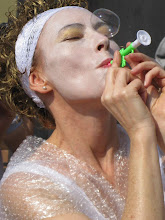
Theme: Expenditure
Period: Sep. 06. - Nov. 15. 2008 (71 days)
Opening ceremony: Sep. 06. 2008
Venues: Busan Museum of Modern Art and others
Exhibitions:
Contemporary Art Exhibition
Sea Art Festival,
Busan Sculpture Project
Participating artists: 183 artists from 34 countries
Host/organizer:
Busan Metropolitan City
Busan Biennale Organizing Committee
Contact: telephone: +82-(0)51-888-6691~9
fax: 82-51-888-6693
email: bbiennale@paran.com
website:
www.busanbiennale.org The 2008 Busan Biennale shows uniqueness of contemporary art from both east and west. 183 artists from 34 countries will represent a distinctive philosophy of "expenditure" and a vivid scene of contemporary art through a variety of artworks including paintings, photographs, videos, installations, outdoor sculptures, etc. Made up of the Contemporary Art Exhibition, the Sea Art Festival and the Busan Sculpture Project, The 2008 Busan Biennale unfolds at the Busan Museum of Modern Art, Gwangalli Beach, APEC Naru Park from September 6th to November 15th.
The Contemporary Art Exhibition will be hosted in the Busan Museum of Modern Art, employing not only the interior spaces of the gallery but also the walls, parking lots, and outdoor spaces nearby to highlight the characteristics of individual art fields. Special exhibits are planned in the measurement room of the Busan Yachting Center, arranging the works of major artists or large-scale installation works. There will be 103artists’ works from 25countries exhibiting.
The exhibits seek to approach contemporary art from critical viewpoints, believing that contemporary art is mired in the trap of reproducing the false images of saturated, oversupplied, repeated symbolic values. Since the symptoms of expenditure appear not only in contemporary society and culture but also in art, especially, in the whole spectrum of contemporary art, it will become a major keyword to reading the latest art trends, which seeks to visualize features of provocation and disintegration.
The Sea Art Festival, which is expected to be a festive venue composed of a variety of works, performances, art and music, will unfold on Gwangalli Beach and nearby areas as a project crossing the boundary between art and everyday life, emphasizing the friendliness of contemporary art. A wide variety of participation art will be exhibited, including ecological works made of environmentally-friendly materials, which will naturally disappear, performance art, and artworks that allow visitors to find or look into something, etc. 58 artists from 18 countries will participate in the festival.
The theme of the Sea Art Festival, "Voyage Without Boundaries," symbolizes the navigation of desires moving toward unfathomable areas. The future seen from the perspective of quantum mechanics is uncertainty itself, emphasizing randomness and unpredictability. Since the future is not determined, it presents freedom and choice, with several factors and motives complementing to participate and engage. The Sea Art Festival brings to the world of reality the conditional "if," which cannot exist in history. The history that we believe is inevitable is rewritten through the distortion of time and space. New artists, who create new artistic - not historical - events, will serve as explorers navigating to find new routes. These new pioneers discover and revise new routes, based upon their intuition and judgement, to find the present address of contemporary art.
The Busan Sculpture Project is inviting 20 artists from 12 countries. The exhibits will be hosted in APEC Naru Park. Materials like stone, concrete, brick, metal, wood will show harmony with grass, flowers, and trees in nature. Going beyond the existing boundary of the sculpture genre, the Project will pursue to harmonize spatial geographical works, such as installation, architecture, landscape architecture, sound, etc. with a city, art, and a garden.
The exhibits will not seek to visually transform a park itself, but rather, extend the epistemological denotation of the space itself. Thus, in addition to artistic and utilitarian works, such as site-specific sculptures and street furniture, the Busan Sculpture Project will be made up of synesthetic works that will change the whole space into one creative space. By installing artworks on the boundaries of a park, the Project will naturally connect what used to be a divided landscape, revealing contemplation on a divide in communication amid advanced information technology and the cure for the problem. The Project will also deal with introspection into an unproductive consumption activity in contemporary consumption-centered society through a stroll on a garden, which is categorized as an "unproductive activity," in contemporary society, where every system is arranged according to the mechanism
of production.
183 artists from 34 countries participate in the 2008 Busan Biennale. Please find how many artists are invited from each country in the followings.
Contemporary Art Exhibition
Georgia 1, The Netherlands 2, Denmark 1, Germany 2, Romania 2, Morocco 1, USA 17, Mexico 1, Venezuela 1, Sweden 1, Switzerland 1, England 4, Israel 1, Italy 2, India 2, Japan 9, China 8, Cyprus 1, Canada 3, Trinidad and Tobago 1, Thailand 5, Portugal 1, France 6, Australia 1 and Korea 29
Sea Art Festival
New Zealand 1, Germany 2, Taiwan 1, Sweden 1, Switzerland 1, Singapore 1, Ireland 1, England 2, Indonesia 1, Japan 7, China 3, Trinidad and Tobago 1, Thailand 1, Poland 2, France 2, Philippines 2, Australia 1 and Korea 30
Busan Sculpture Project
New Zealand 1, The Netherlands 1, USA 2, Vietnam 1, Scotland 1, Ireland 1, England 1, Indonesia 1, Japan 2, China 2, Canada 1 and Korea 6
Busan Biennale 2008
Sep. 6 - Nov. 15, 2008,
Press Opening
Sep. 5. 2008, Auditorium at the Busan Museum of Modern Art
Opening Ceremony
Sep. 6. 2008















